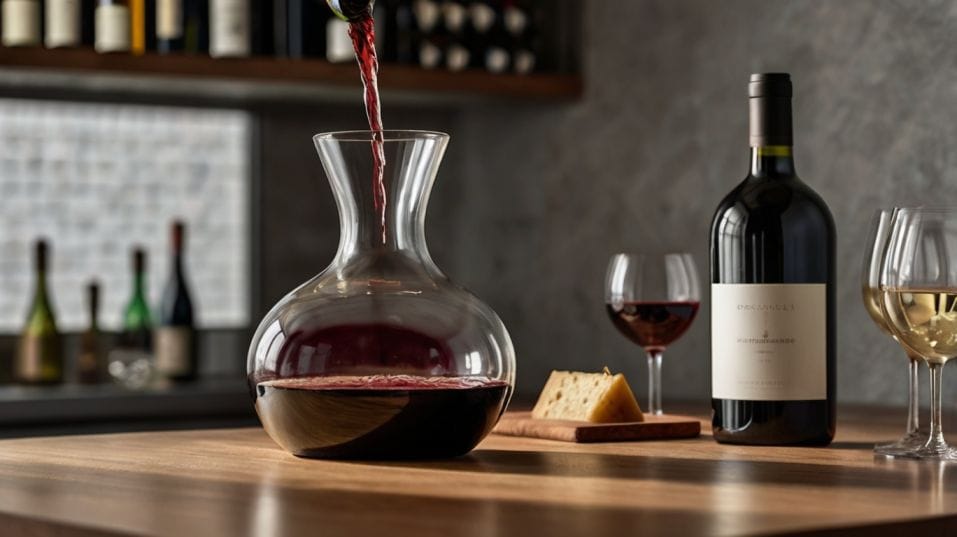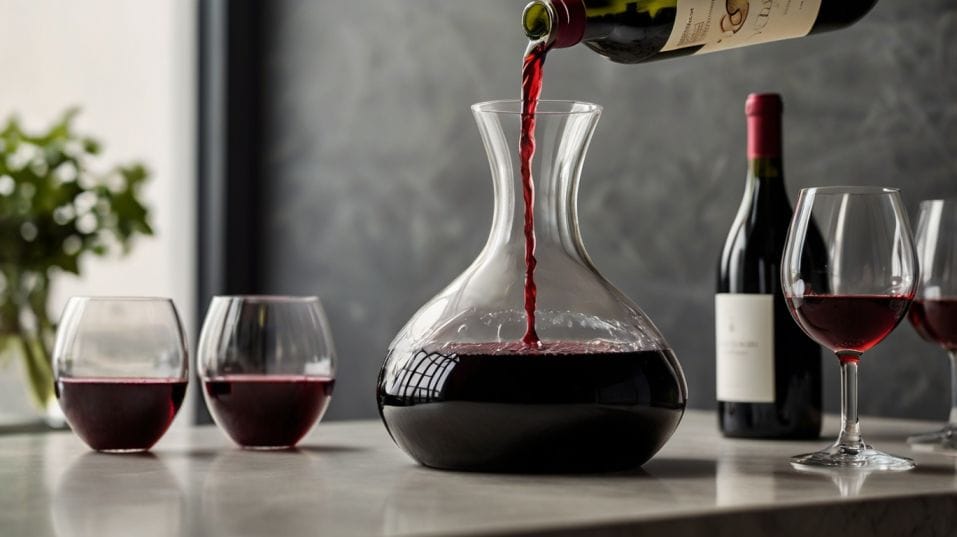How to Use a Decanter Without Feeling Fancy
Think decanting is for sommeliers? Think again. Learn how and when to decant wine with confidence—no crystal, rituals, or guesswork required.

Ever wonder what a decanter actually does—and whether you need one at all? If you’re just starting to care about more than just “red or white,” this small tool can unlock more flavor, texture, and insight than you’d expect.
No opera. No crystal swans. Just a clear, focused way to taste wine more intentionally. Here’s how to use a decanter—not to impress anyone, but to better understand what’s in your glass.
What Decanting Actually Does (and Doesn’t)
Let’s cut through the mystique. Decanting wine does two main things: it helps the wine breathe, and it separates it from sediment.
Breathing and Sediment
Breathing, or oxygen exposure, starts a slow, controlled transformation. Aromas expand. Textures soften. Harsh edges melt down. In young wines, this can be the difference between "tight and grippy" and "layered and expressive."
Sediment, on the other hand, is a natural byproduct of aging. It’s harmless but gritty—and it can muddy both the clarity and flavor of older wines, especially reds. Decanting lets you pour off the clear wine while leaving the sediment behind.

Focus and Intention
But there’s also a third, less tangible benefit: focus. Decanting slows you down. It gets you tasting with intention.
And that simple act—pausing, pouring, swirling, sipping—teaches you more about wine than any tasting wheel or scoring system ever will.
This isn’t about “doing it right.” It’s about creating the conditions to experience a wine more fully. That’s what decanting offers. Nothing more. Nothing less.
When It Helps—and When It Doesn’t
Not every wine needs to be decanted. But almost any wine can be improved by thoughtful oxygen exposure, especially if you know what to look for.
Young Reds and Bold Wines
Young red wines—Cabernet, Syrah, Malbec, Nebbiolo, Bordeaux blends—often come out of the bottle tight, tannic, and aromatically closed.
A decanter helps accelerate the softening process that would normally happen over hours in your glass. This is especially true for wines under 10 years old that are structured, bold, or still developing.
Natural Wines and Whites
Natural wines or those with minimal sulfur can behave unpredictably. Some need air to settle and find balance; others unravel quickly. This is where decanting half the bottle and tasting side-by-side pays off. Use it as a lab—not a rulebook.
White wines, especially those with texture, age, or oak influence (think White Burgundy, serious California Chardonnay, or aged Alsace), can benefit more than most people expect.
Air brings out tertiary aromas and calms any initial sulfur notes. Just keep the wine cool as it breathes.
Sparkling and Delicate Wines
Even sparkling wine can be decanted. Yes, you’ll lose bubbles, but in the right context—Champagne with age, high-end grower fizz, or Pet-Nat—it can be worth it. You trade fizz for finesse.
When should you not decant? With delicate old wines—especially 20+ years—be careful. Too much air can strip subtlety and collapse a fragile structure.
Taste first, decant gently if needed, and serve soon after. You’re trying to protect the wine’s integrity, not show it off.
How to Decant Without Pretending You’re in a Tasting Room
Here’s the part most people overthink. Decanting isn’t a ritual—it’s a process. You don’t need a vintage crystal swan or a $300 aerator. What matters is how you handle the wine.
The Basics of Pouring
Start by opening the bottle and taking a quick smell. Is it muted, tight, a little funky? That’s your cue.
Then pour slowly into the decanter, letting the wine roll down the inner surface. You're not just transferring it—you’re exposing it. Give it air, but don’t beat it up.
For younger wines, you can pour a bit more vigorously. For older wines, go slow and steady, watching the neck of the bottle for sediment as you near the bottom.
If you’re decanting to avoid sediment, hold a light source (a candle, flashlight, or phone) behind the bottle and stop pouring once the sediment approaches the neck.
No Decanter? No Problem.
And if you’re just working with what’s on hand? A clean glass pitcher, wide carafe, or even a large mason jar can do the job. Wine doesn’t care about design—it cares about exposure.
Want to keep your table neat? Try double-decanting. Pour the wine into a decanter to give it air, then funnel it back into the clean bottle for serving. Label it if needed. It’s efficient, and it earns points with minimal fuss.
How Long Is Enough?
This is where decanting becomes less science, more art. There’s no exact timing, only guidelines and observation.
Timing by Type
Young, bold wines can benefit from 30 minutes to an hour in a decanter. Some structured reds, like Barolo or Bordeaux, might take longer to open fully.
Lighter reds—Gamay, Pinot Noir, some Chianti—often evolve quickly. White wines can show subtle changes within 10 to 20 minutes. Sparkling? Think in terms of five-minute windows, not hours.
The Key: Taste Over Time
But here’s the key: Taste the wine multiple times. Take a sip right after opening. Again 10 minutes later. Again halfway through dinner.
You’ll start to notice how air changes aroma, mouthfeel, and finish. This is how you train your palate—not by memorizing flavor notes, but by tracking transformation.
Don’t be afraid to experiment. Open two bottles—decant one, leave one untouched. Pour both blind for a friend. Compare. Talk. Learn. This is where wine becomes personal, not performative.
The Psychological Shift: Why This Matters
It’s easy to think of decanting as something you “graduate to” when you know more, spend more, or host more. But in reality, it’s something that teaches you to know more—about wine, yes, but also about your preferences.
By decanting, you create space to pay attention. And when you do that consistently, you stop drinking wine out of habit and start drinking it with curiosity.
You notice which grapes you love young and wild, and which ones reward patience. You build confidence—quietly, without needing permission. Decanting doesn’t make you fancy. It makes you focused.
Final Thoughts
A decanter doesn’t need to be expensive. It doesn’t need to be pretty. And it doesn’t need to come with rules. What it does need is your attention.
Decanting is one of the simplest, clearest ways to get more out of every bottle you open. It doesn’t require expert knowledge—just the willingness to slow down, taste intentionally, and be open to what changes. The wine will do the rest.
So go ahead: pour that weeknight red into a wide glass jar. Swirl your white Burgundy before the first sip. Watch a wine unfold, not because someone told you to—but because you’re starting to trust your own palate.
Try something. Taste something. Add one new layer to your ritual. Wine doesn’t have to be complicated to be captivating. Sometimes, all it needs is a little air.




